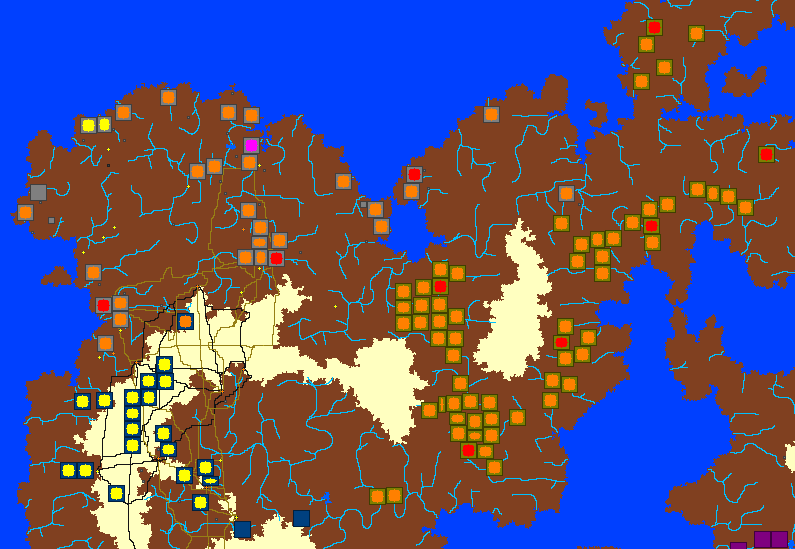- v50 information can now be added to pages in the main namespace. v0.47 information can still be found in the DF2014 namespace. See here for more details on the new versioning policy.
- Use this page to report any issues related to the migration.
Religion
v50.12 · v0.47.05 This article is about the current version of DF.Note that some content may still need to be updated. |
| This page contains information only relevant to DF 0.47.01 and newer. Most or all of this information does not apply to previous versions. Older saves from previous versions in the DF2014 release cycle are still compatible with this version. |
Religions are the organized worship of deities. Only dwarves and humans worship deities; elves instead believe in a single force that permeates the forests, while goblin worship is monopolized by their ruler.
World Generation
In world generation, some historical figures will become prophets, linked to a deity. Prophets will be the source of a religion, which can either be monastic, or non-monastic, and a single deity can be the subject of many different religions. In both cases, the prophet will convert parts of the population to the religion in question.
In the case of monastic orders, the head will be an Abbot, and the followers will try to build a monastery, which they will first seek sponsorship for from other groups, such as site governments or craftguilds. Monastic orders will occasionally recruit monks from sites to increase their population.
In the case of non-monastic religions, as the amount of followers increases in a site, they will have a shrine dedicated to their religion, as well as a local priest. Priests will convert more of the population to their religion. Eventually, in towns, temples will be built and a high priest will be selected. Once two temples in different cities have been built, a Holy city is selected from the existing temple towns and the highest priest is selected. These positions will typically have an utterly bizarre title (such as "great orange") that comes from the sphere which their deity is aligned with. Within adventure mode, they will also greet you in the strangest way ("Life is, in a word, death.").
Religions will spread past cultural barriers, as an export of the religion map (available when selecting a religion from the entities list in legends mode) shows:

In terms of intrigue, religions will sometimes be subject to religious persecution by the local site government. This will lead to the destruction of sacred sites and the expulsion of believers. Persecution grudges can be formed by subjected historical figures towards the official(s) responsible, and may thus plot their downfall. Priests can also perform sermons, where they may implore their followers to show kindness or disdain towards another group.
In Fortress mode
Each of your dwarven inhabitants has some, or several objects of worship: these include deities, but also megabeasts. In the case of deities, there are four different levels of worship, in decreasing order: "ardent", "faithful", "casual", "dubious". Regardless, any deity-worshipping dwarf will sometimes have a need to commune with their deity at a temple, and will do so when they have free time. Praying evokes a very strong and positive enraptured emotion, so the effects of temples on your citizens' well-being should not be underestimated. Dwarves that are unable to pray may feel distracted and receive unhappy thoughts. The exact inner workings are unclear, but the importance of such effects presumably depends on the strength of the need and the level of worship. There are many religions, and your dwarves' religious needs don't overlap that much, so you may need to designate several temples to satisfy your whole population.
As your fort gains new residents from different civilizations, whether they petitioned for citizenships or were rescued from another site by a squad sent on a mission, the list of available religions may increase. As detailed on the temple page, as enough followers of a given religion join your fort, you will be petitioned for a temple and asked to select a priest. Priests are be able to console upset dwarves the same way mayors do, and may give inspiring sermons.
In Adventure mode
Towns typically feature temples inhabited by a high priest of some kind. In the current version, you are not able to join a religion during play, but are able to select a religion from the creation screen.
Temples are also the home for holy relics, a special kind of artifact. Holy relics are usually a piece of clothing or a body part of a late high priest. Holy relics can be stolen or plundered in world generation, in which case the entity will send questers to attempt to retrieve it. You may encounter one of those questers, or become one yourself. If you steal a holy relic yourself, and make it known by bragging about it, you will alienate the religion and its questers.
You are also able to give sermons as a type of performance. These sermons can be about a value or regarding a deity your adventurer believes in. Like the other performances, this will give your adventurer the reputation of being a preacher. Sermons don't allow building a flock yet, but this is planned.
Vampires are also able to form minor cults focused on their peculiar 'immortality worship'. If you encounter a vampire in the middle of their cultists and confront them, the cultists will turn against you.